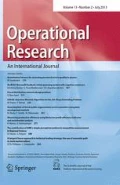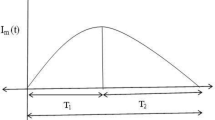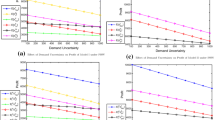Abstract
In this paper, an economic production quantity model in a three levels supply chain including multiple non-competing suppliers, single manufacturer and multiple non-competing retailers for multiple products with rework process under integrated and non-integrated structures is developed. In this chain, suppliers ship raw material to the manufacturer and the manufacturer combines the fixed percentage of different kinds of raw material to produce the finished products and then delivers them to the retailers. The Stackelberg game is established among the members of the chain. Optimizing the total profit of the chain under both structures applying the optimal pricing, inventory and production policies is the purpose of the research. Eventually, a numerical example is presented for comparing the total profit of the integrated and non-integrated chains of proposed model and some sensitivity analyses are performed to study the effects of parameter changes on the decision variables and the chain profit.












Similar content being viewed by others
References
Abad PL (2003) Optimal pricing and lot-sizing under conditions of perishability, finite production and partial backordering and lost sale. Eur J Oper Res 144(3):677–685
Ben-Daya M, Asad R, Seliaman M (2013) An integrated production inventory model with raw material replenishment considerations in a three layer supply chain. Int J Prod Econ 143(1):53–61
Cárdenas-Barrón LE (2007) Optimizing inventory decisions in a multi-stage multi-customer supply chain: a note. Transp Res Part E 43(5):647–654
Cárdenas-Barrón LE (2008) Optimal manufacturing batch size with rework in a single-stage production system: a simple derivation. Comput Ind Eng 55(4):758–765
Cárdenas-Barrón LE, Teng JT, Treviño-Garza G, Wee HM, Lou KR (2012a) An improved algorithm and solution on an integrated production-inventory model in a three-layer supply chain. Int J Prod Econ 136(2):384–388
Cárdenas-Barrón LE, Treviño-Garza G, Wee HM (2012b) A simple and better algorithm to solve the vendor managed inventory control system of multi-product multi-constraint economic order quantity model. Expert Syst Appl 39(3):3888–3895
Cárdenas-Barrón LE, Treviño-Garza G, Widyadana GA, Wee HM (2014) A constrained multi-products EPQ inventory model with discrete delivery order and lot size. Appl Math Comput 230(1):359–370
Chakraborty T, Giri BC (2014) Lot sizing in a deteriorating production system under inspections, imperfect maintenance and reworks. Oper Res Int J 14:29–50. doi:10.1007/s12351-013-0134-5
Cheng TCE (1991) An economic order quantity model with demand-dependent unit production cost and imperfect production processes. IIE Trans 23(1):23–28
Chiu YP (2003) Determining the optimal lot size for the finite production model with random defective rate, the rework process, and backlogging. Eng Optim 35(4):427–437
Chiu SW, Gong DC, Wee HM (2004) Effects of random defective rate and imperfect rework process on economic production quantity model. Jpn J Ind Appl Math 21(3):375–389
Dada M, Srikanth K (1987) Pricing policies for quantity discounts. Manage Sci 33(10):1247–1252
Esmaeili M, Aryanezhad MB, Zeephongsekul P (2009) A game theory approach in seller–buyer supply chain. Eur J Oper Res 191(2):442–448
He Y (2013) Sequential price and quantity decisions under supply and demand risks. Int J Prod Econ 141(2):541–551
Hua G, Wang S, Cheng TCE (2012) Optimal order lot sizing and pricing with free shipping. Eur J Oper Res 218(2):435–441
Jamal AMM, Sarker BR, Mondal S (2004) Optimal manufacturing batch size with rework process at a single-stage production system. Comput Ind Eng 47(1):77–89
Jonrinaldi A, Zhang DZ (2013) An integrated production and inventory model for a whole manufacturing supply chain involving reverse logistics with finite horizon period. Omega 41(3):598–620
Leng M, Parlar M (2010) Game-theoretic analyzes of decentralized assembly supply chains: non-cooperative equilibrium vs. coordination with cost-sharing contracts. Eur J Oper Res 204(1):96–104
Lim S (2013) A joint optimal pricing and order quantity model under parameter uncertainty and its practical implementation. Omega 41(6):998–1007
Migdalas A (2002) Applications of game theory in finance and managerial accounting. Oper Res Int J 2(2):209–241
Mutlu F, Cetinkaya S (2013) Pricing decisions in a carrier-retailer channel under price-sensitive demand and contract-carriage with common-carriage option. Transp Res E Logist Transp Rev 51(1):28–40
Pal B, Sana SS, Chaudhuri K (2012a) A three layer multi-item production–inventory model for multiple suppliers and retailers. Econ Model 29(6):2704–2710
Pal B, Sana SS, Chaudhuri K (2012b) Three-layer supply chain: a production-inventory model for reworkable items. Appl Math Comput 219(2):530–543
Pal B, Sana SS, Chaudhuri K (2013) Maximizing profits for an EPQ model with unreliable machine and rework of random defective items. Int J Syst Sci 44(3):582–594
Parthasarathi G, Sarmah SP, Jenamani M (2011) Supply chain coordination under retail competition using stock dependent price-setting newsvendor framework. Oper Res Int J 11:259–279. doi:10.1007/s12351-010-0077-z
Rosenblatt MJ, Lee HL (1986) Economic production cycles with imperfect production processes. IIE Trans 18(1):48–55
Rosenthal EC (2008) A game-theoretic approach to transfer pricing in a vertically integrated supply chain. Int J Prod Econ 115(2):542–552
Sana SS (2011) A production-inventory model of imperfect quality products in a three-layer supply chain. Decis Support Syst 50(2):539–547
Seyed-Esfahani MM, Biazaran M, Gharakhani M (2011) A game theoretic approach to coordinate pricing and vertical co-op advertising in manufacturer-retailer supply chains. Eur J Oper Res 211(2):263–273
Soon W (2011) A review of multi-product pricing models. Appl Math Comput 217(21):8149–8165
Taleizadeh AA, Noori-daryan M (2014) Pricing, manufacturing and inventory policies for raw material in a three-level supply chain. Int J Syst Sci (in press)
Taleizadeh AA, Najafi AA, Niaki STA (2010a) Economic production quantity model with scraped items and limited production capacity. Int J Sci Technol 17(1):58–69
Taleizadeh AA, Niaki STA, Najafi AA (2010b) Multiproduct single-machine production system with stochastic scrapped production rate, partial backordering and service level constraint. J Comput Appl Math 233(8):1834–1849
Taleizadeh AA, Wee HM, Sadjadi SJ (2010c) Multi-product production quantity model with repair failure and partial back-ordering. Comput Ind Eng 59(1):45–54
Taleizadeh AA, Widyadana GA, Wee HM, Biabani J (2011a) Multi products single machine economic production quantity model with multiple batch size. Int J Ind Eng Comput 2(2):213–224
Taleizadeh AA, Sadjadi SJ, Niaki STA (2011b) Multi-product single-machine EPQ model with immediate rework process and back-ordering. Eur J Indus Eng 5(4):388–411
Taleizadeh AA, Cárdenas-Barrón LE, Biabani J, Nikousokhan R (2012) Multi products single machine EPQ model with immediate rework process. Int J Ind Eng Comput 3(2):93–102
Thangam A, Uthayakumar R (2010) Optimal pricing and lot-sizing policy for a two-warehouse supply chain system with perishable items under partial trade credit financing. Oper Res Int J 10:133–161. doi:10.1007/s12351-009-0066-2
Transchel S, Minner S (2009) The impact of dynamic pricing on the economic order decision. Eur J Oper Res 198(3):773–789
Xiao T, Jin J, Chen G, Shi J, Xie M (2010) Ordering, wholesale pricing and lead-time decisions in a three-stage supply chain under demand uncertainty. Comput Ind Eng 59(4):840–852
Zhang CT, Liu LP (2013) Research on coordination mechanism in three-level green supply chain under non-cooperative game. Appl Math Model 37(5):3369–3379
Acknowledgments
The authors thank the three anonymous reviewers for their helpful suggestions which have strongly enhanced this paper. The first author would like to thank the financial support of the University of Tehran for this research under Grant Number 30015-1-02.
Author information
Authors and Affiliations
Corresponding author
Appendix: Proofing the concavity of TP(q k , S r i )
Appendix: Proofing the concavity of TP(q k , S r i )
TP(q k , S r i ) is concave when \( {\text{X}} . {\text{H}} . {\text{X}}^{T} < 0, \) where \( X = \left[ {\begin{array}{*{20}c} {q_{k} } & {S_{i}^{r} } \\ \end{array} } \right],\quad X^{T} = \left[ {\begin{array}{*{20}c} {q_{k} } \\ {S_{i}^{r} } \\ \end{array} } \right],\quad H = \left[ {\begin{array}{*{20}c} {\frac{{\partial^{2} TP(q_{k} ,S_{i}^{r} )}}{{\partial q_{k}^{2} }}} & {\frac{{\partial^{2} TP(q_{k} ,S_{i}^{r} )}}{{\partial q_{k} \partial S_{i}^{r} }}} \\ {\frac{{\partial^{2} TP(q_{k} ,S_{i}^{r} )}}{{\partial S_{i}^{r} \partial q_{k} }}} & {\frac{{\partial^{2} TP(q_{k} ,S_{i}^{r} )}}{{\partial S_{i}^{r2} }}} \\ \end{array} } \right] \) and
Then, we have:
where,
Therefore, we have:
Furthermore, the concavityFurthermore, the concavity is obvious.
Rights and permissions
About this article
Cite this article
Taleizadeh, A.A., Noori-daryan, M. Pricing, inventory and production policies in a supply chain of pharmacological products with rework process: a game theoretic approach. Oper Res Int J 16, 89–115 (2016). https://doi.org/10.1007/s12351-015-0188-7
Received:
Revised:
Accepted:
Published:
Issue Date:
DOI: https://doi.org/10.1007/s12351-015-0188-7




